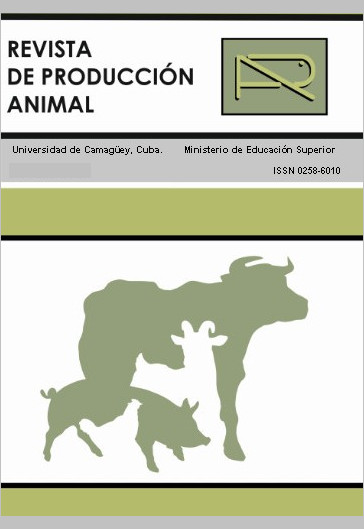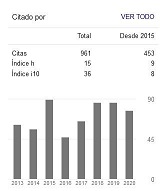Validación de heces ovinas con la técnica de gas in vitro para valorar alimentos destinados a rumiantes.
Resumen
Se evaluaron heces ovinas depuestas comoinóculo enla técnica de producción de gases para la valoración nutriti-va invitroe insaccode lospastos tropicales:tejana (Paspalum notatun), estrella (Cynodon nlemfuensis), guinea
(Panicum maximun), pajilla (Sporobolus indicus) yleguminosa rastrera(Desmodiumsp).Las heces procedían de
animales que consumían pastos de gramíneas. Inyecciones sistemáticas de CO2 impidieron que los microorganismos
anaerobios estrictos contactaran con el oxígeno. Existiócorrelación positiva y significativa entre la producciónde
gas con heces ovinas depuestas y la producción de gas con líquido ruminal de ovinos. El coeficiente de determina-ciónfue de 0,79. El mayor valor nutritivo lo alcanzaronlos pastos guinea (Panicum maximum) y estrella(Cynodon
nlemfuensis) y el menorpajilla (Sporobolusindicus).
Ovine Excreta Validation Through invitroBiogasification to Assess Pastures
for Ruminants Feeding
ABSTRACT
Ovine excreta as inoculumfor biogasication wasused to assess in vitroand insacco nutritive value of tropical pas-tures for ruminants.Pasturesunder studywere: Paspalum notatun, Cynodon nlemfuensis, Panicum maximum,
Sporobolus indicus, andDesmodiumsp. Excreta were collected on grassypastures areas. CO2systematic injections
preventedstrict anaerobic microorganismscontact withoxygen. A positive andsignificant correlation resulted from
biogasification usingeither ovine excreta orovine ruminalfluid. Determinantcoefficientwas 0,79. Panicum maxi-mum and Cynodon nlemfuensis reached the highest nutritive value, while Sporobolus indicus showedthe lowestone.
Descargas
Citas
AKHTER, S. y HOSSAIN, M. M. (1998). Cow Faeces in vitro Digestibility Assays of Forages. Asian-Australasian Journal of Animal Sciences, 11(1), 51-54.
AKHTER, S.; OWEN, E. y HOSSAIN, M. M. (1996). Use of Cow Faeces at Different Times after Being Voided as a Source of Micro-Organisms in vitro Digestibility Assays of Forages. Asian-Australasian Journal of Animal Sciences, 9(4), 371-374.
AKHTER, S.; OWEN, E.; THEODOROU, M. K.; BUTLER, E. A. y MINSON, D. J. (1999). Bovine Faeces as a Source of Micro-Organisms for the in vitro Digestibility Assay of Forages. Blackwell Science Ltd, Grass and Forage Science, 54, 219-226.
BUENO, I. C.; CABRALFILHO, S. L.; GOBBOA, S. P.; LOUVANDINI, H.; VITTI, D. M y ABDALLA, A. L. (2005). Influence of Inoculum Source in a Gas Production Method. Animal Feed Science and Technology, 123-124 y 95-105.
CONE, J. W.; VANGELDER, A. H. y BACHMANN, H. (2002). Influence of Inoculum Source on Gas Production Profiles. Anim. Feed Sci. Technol., 99, 221-231.
DEL TORO, A.(2008). Estrategia curricular de formación bioética para el desarrollo humano sostenible. Tesis de doctorado en Ciencias Pedagógicas, Universidad de Camagüey,Cuba.
DHANOA, M. S.; FRANCE, J.; CROMPTON, L. A.; MAURICIO, R. M.; KEBREAB, E.; MILLS, J.A.N.; SANDERSON, R.; DIJKSTRA, J. y LÓPEZ, S. (2004). Technical Note: A Proposed Method to Determine the Exten tof Degradation of a Feedin the Rumen from the Degradation Profile obtained with the in vitro Gas Production Technique Using Feces as the Inoculum. J. Anim. Sci., 82, 746.
FAO. (2008). Ayudando adesarrollar una ganadería sustentable en Latinoaméricay el caribe: lecciones a partir de casos exitosos. Chile, Santiagode Chile: Oficina Regional para América Latina y el Caribe. Organización de las Naciones Unidas para la Agriculturay la Alimentación.
FRANCE, J.; THEODOROU, M. K.; LOWMAN, R. S. y BEEVER, D.E. (2000). Feed Evaluation for Animal Production. En Theodorou, M. K.y France, J. (Eds.). Feeding Systems and Feed Evaluation Mod-els. Wallingford,UK: CAB International.
GETACHEW, G.; DEPETERS, E. y ROBINSON, P. (2004). In vitro Gas Production Provides Effective Method for Assessing Ruminant Feeds. California Agriculture, Jan-Mar. Extraído en febrero 2009, desde http://www.bioparametrics.com/Pdf/Neil%20Jessop%20Publications.pdf.
HERNÁNDEZ, J.E. (2006). Valoración de lacaprino-cultura en la mixteca poblana: socio economía y recursos arbóreo-arbustivos. Tesis de doctorado en Ciencias Veterinarias, Universidad de Camagüey, Cuba.
HOLTER, P. (1991). Concentration of Oxygen, Carbon-Dioxide and Methane inthe Air within Dung Pats. Pedobiología, 35, 381-386.
MARTÍNEZ, S. J.(2005). Implementación de la técnica de producción de gas in vitro con heces vacunas como inóculo y su empleo para evaluar el follaje de algunas leguminosas arbustivas. Tesis de maestría en Producción Bovina Sostenible, Facultad de Ciencias Agropecuarias, Universidad de Camagüey, Cuba.
MARTÍNEZ,S. J. (2008). Heces vacunas depuestas como inóculo en la técnica deproducción de gases para lavaloración nutritiva in vitro deforrajes. Tesis de doctorado en Ciencias Veterinarias, Universidad de Camagüey, Cuba.
MAURICIO, R. M.; OWEN, E.; MOULD, F. L.; GIVENS, D. I.; THEODOROU, M. K.; FRANCE, D.; DAVIESR. y DHANOA, M. S. (2001). Comparison of Bovine Rumen Liquor and Bovine Faeces as Inoculum for an in vitro Gas Production Technique for Evaluating Forages. Anim. Feed Sci.Technol, 89, 33-48.
MCDONALD, P.; EDWARDS, R. A.; GREENHALGH, J. F. D. y MORGAN, C.A. (2002). Evaluation of Foods. Digestibility. En Animal Nutrition (Sixth Edition). Pearson. Prentice-Hall.
MENKE, K. H.y STEINGASS, H. (1988). Estimation of the Energetic Feed Value Obtained from Chemical Analysis and invitro Gas Production Using Rumen Fluid. Animal Research and Development, 28, 7-55.
MENKE, K.H.; RAAB, L.; SALEWSKI, A.; STEINGASS, H.; FRITZ, D.y SCHNEIDER, W.(1979). The Estimationof the Digestibility and Metabolizable Energy Content of Ruminant Feeding stuffs from
the Gas Production whenthey are Incubated with Rumen Liquor in vitro. J. agric. Sci, 93, 217-222.
MERTENS, D. R.; WEIMER, P. J.y WAGHORNG. C. (1997). Inocula Differences Affect invitro Gas Production Kinetics. Research Summaries. Extraído el 16 de agosto de 2008, desde www.dfrc.wisc.edu/RS97pdfs/ RM2.pdf.
MOORE, K. J. y JUNG,H.J. G.(2001). Ligninand Fiber Digestion. Journal of Range Management, 54, 420-429.
MOULD, F. L.; MORGAN, R.; KLIEM, K. E. y KRYSTALLIDOU, E. (2005). A Review and Simplification of the invitro Incubation Medium. Animal Feed Science and Technology, 123-124, pp. 155-172.
NAGADI, S.; HERRERO, M. y JESSOP, N.S. (2000). The Influence of Diet ofthe Donor Animal on the Initial Bacterial Concentration of Ruminal Fluid and in vitro Gas Production Degradability Parameters. Anim. Feed Sci.Technol., 87, 231-239.
ØRSKOV, E. R. (1999). Nutriciónde rumiantes. Curso de Posgrado. Universidad de Camagüey, Cuba.
PANIN, A.(2000). AComparative Economic Analysis of Smallholder Cattleand Small Ruminant Production Systems in Botswana. Tropical Animal Health and Production, 32(3), 189-196.
PEDRAZA, R.M.(1998). Use of invitro Gas Production Techniqueto Assess the Contribution of Both Soluble and Insoluble Fractions onthe Nutritive Value of Forages. MSc thesis, University of Aberdeen, Scotland.
PRESTON, T. R.(2003). Producción Agropecuaria Sostenible: crisisu oportunidad. Taller Internacional: Ganadería, desarrollo sostenible y medio ambiente, marzo, La Habana.
RAMACHANDRA, B. y KRISHNAMOORTHY, U. (2000). Evaluation of Some Feeds by invitro Gas Production. Indian Veterinary Journal, 77(11), 976-978.
RESILLEZ, P. A. (2008). Producciónde gases con heces vacunas depuestas como inóculo para predecir la degradabilidad insitude forrajes. Tesis de maestría en Producción Bovina Sostenible, Universidad de Camagüey, Cuba.
RYMER, C.; HUNTINGTON, J.A.y GIVENS, D. I. (1999). Effects of Inoculum Preparation Method and Concentration, Method of Inoculation and Pre-Soakingthe Substrate on the Gas Production Profile of High Temperature Dried Grass. Anim. Feed Sci. Technol.,78, 199-213.
THEODOROU, M. K.; WILLIAMS, B. A.; DHANOA, M. S.; MCALLAN, A. B. y FRANCE,J.(1994). A Simple Gas Production Method Usinga Pressure Transducer to Determine the Fermentation Kinetics of Ruminant Feeds. Animal Feed Science and Technology, 48, 185-197.
TILLEY, J. M. A. y TERRY, R. A.(1963). A Two Stage Technique for the in vitro Digestion of Forage Crops. Journal of the British Grassland Society, 18, 104-111.
TSCHERNING, K.; BARRIOS, E.; LASCANO, C.; PETERS, M. y SCHULTZE-KRAFT, R. (2002). Comparison of Aerobic and Anaerobic Methods to Assess Quality of Tropical Multipurpose Shrub Legumes. Extraído el 10 de agosto de 2009,desde http://mars.wiz.uni-kas-sel.de/tropentag/proceedings/2002/htmL/node153.
VAN THU, N. (2003). Effect of Different Strategies of Treated Rice Straw on Nutrients and invitro OM Digestibility by Using Rumen Fluidor Faecal Inocula of Local Cattle; En Reg Prestony Brian Ogle (Eds). Proceedings of Final National Seminar-Work shop on Sustainable Livestock Production on Local Feed Resources. Hue City: HUAF-SAREC. Extraído en abril de2009, desde http://www.mekarn.org/sarec03/thu2.htm
VAN THU, N. (2003). Inoculum from Sheep. Animal Feed Scienceand Technology, 123-124,81-94.
Los autores de los artículos publicados en RPA retienen los derechos de autor de su trabajo, de marca y patente, y también sobre cualquier proceso o procedimiento descrito en el artículo, así como a compartir, copiar, distribuir, ejecutar y comunicar públicamente el artículo publicado en la RPA o cualquier parte de aquel siempre que indiquen la fuente de publicación (autores del trabajo, revista, volumen, número y fecha), pero están de acuerdo en que la revista publique los trabajos bajo una licencia Creative Commons.
![]() Licencia Attribution-NonCommercial 4.0 International (CC BY-NC 4.0)
Licencia Attribution-NonCommercial 4.0 International (CC BY-NC 4.0)






































